“Pinocchio: A Theological Tale for our Times” is a four-talk presentation guided by Fr. Gregory Hrynkiw at St. Anne’s Church in the Saskatchewan city. But it is not concerned so much with the classic 1940 feature-length Disney animation or other films based on Italian writer Carlo Collodi’s — the pen name of Carlo Lorenzini — original children’s novel, The Adventures of Pinocchio (1883), though the subject matter is getting the deep dive treatment.
“Part of the method I do in my teaching is bringing people back to the original text and letting the text speak,” said Hrynkiw, a Byzantine-Catholic monk since 1989. “We just get so many versions of things that are digested for us and presented in a visual way that it affects our understanding.”
Hrynkiw, who swore a solemn profession of monastic vows into the Hermitage of the Three Holy Hierarchs in 2010, wants attendees to take away heightened critical-thinking and truth-seeking capacities as a result of this experience. To stimulate the most enriching scholarship and discussions during the event, registrants are encouraged to purchase an original Oxford edition of Pinocchio for an additional $5 to familiarize themselves with the source material.
“Pinocchiocity” — his term — became a theological passion for Hrynkiw during various stints living in Rome dating back to 1991, where he immersed himself into Italian literature and culture. He became very familiar with the work of Cardinal Giacomo Biffi, the Archbishop of Bologna from 1984 to 2003.
In the 1970s, Hrynkiw said Biffi extensively studied Pinocchio. The story meant a lot to Biffi as a child growing up in northern Italy. Analyzing this book was “a struggle” for Biffi, said Hrynkiw, but Biffi ultimately unearthed some striking revelations.
“He found that the book did not have an ambiguous, moralistic message, but that the book revealed the true nature of the universe, the world and of mankind,” said Hrynkiw. “He saw Pinocchio as a metaphor for humanity as a whole, and each person. He saw the universal appeal of the book and that it had a certain Catholicity.”
Divinization, also known as theosis, the transformative process of becoming more alike and unified with God through grace, atonement and the spirit of God, is an overarching Catholic element of Pinocchio, said Hrynkiw.
“Pinocchio has this woody nature, right? But he is called to share in the nature of his father Geppetto — a transfiguration to become a real boy. It really expresses our journey back to the father — the prodigal son that we all are — and we are called to share in the nature of our Father and experience His love for all eternity.”
Various characters in the narrative are steeped in symbolism, said Hrynkiw. The blue fairy represents the “feminine nature of the Church” and the mediation of the Church.
Conscience is famously depicted by the talking cricket — Jiminy Cricket in the Disney film — and Pinocchio’s decision in the book to kill the cricket represents the death of conscience when we don’t listen. This is emblematic of the consequences that come when we do not live by God’s Ten Commandments.
Hrynkiw said more peripheral characters and settings communicate allegory, such as the place called Toyland.
“This place ultimately enslaves boys who are working there to the point that they become donkeys. Pinocchio’s friend Candlewick, for example, actually loses his identity and becomes a donkey,” he said.
“The further we drift away from the Father, the more we lose our own identity and humanity. There is a constant dehumanization of Pinocchio, and this theme is very prevalent in our world today.”
Collodi, who was politically active, wrote this book during a late 19th-century Italy experiencing an “epoch of change,” Hrynkiw said, because of the unification of different states of the Italian peninsula into a single state in 1861.
Collodi became very “disillusioned and pessimistic about this movement,” in Hrynkiw’s view, because there was already a unified spirit among the people living in these regions at the time. An artificially-imposed unity through this consolidation was not seen as ideal in the end.
Hrynkiw said Collodi’s pessimistic state influenced him to end his original submitted draft in chapter 15 when Pinocchio was hung on the great oak, and the blue fairy cannot intervene because she is dead.
However, the children recruited by Collodi’s editor to review the manuscript wrote a note that the book cannot end in this fashion, and that Pinocchio must be resurrected.
“All of a sudden this book that was incredibly nihilistic and pessimistic takes on all these eternal qualities and the truths of the Catholic Church,” said Hrynkiw. “The fairy, in addition to representing the feminine principle of the Church, represents wisdom as an incarnate principle.”
Free will is evident throughout Pinocchio’s pages as the protagonist can choose, or not, to adopt the nature of his father. Pinocchio’s kicks and other attacks against Geppetto when the latter was carving could denote the concept of original sin.


